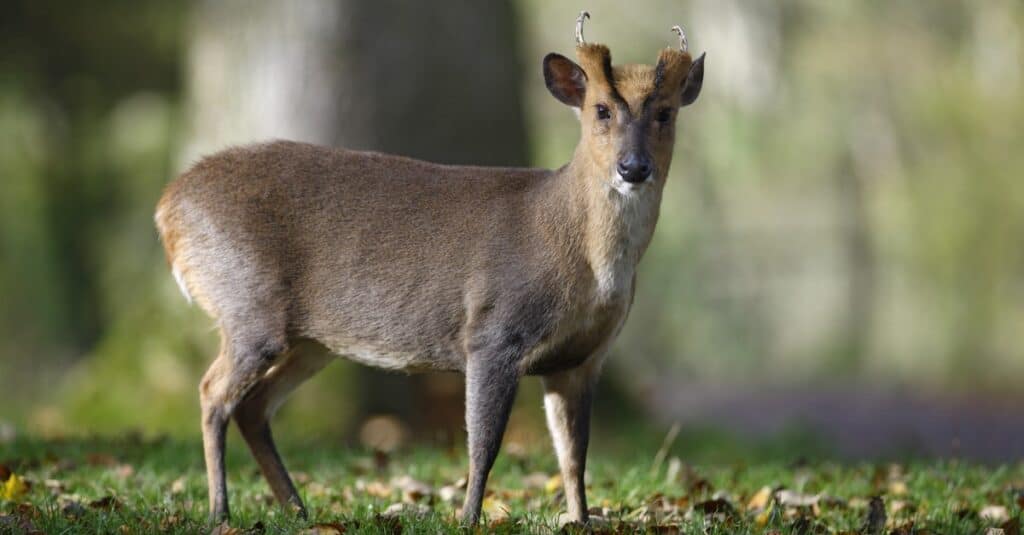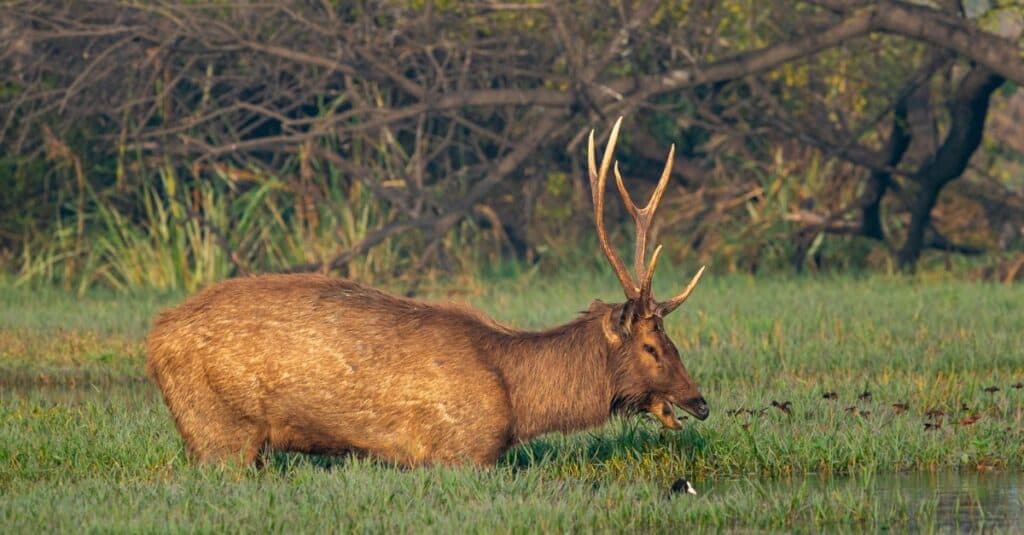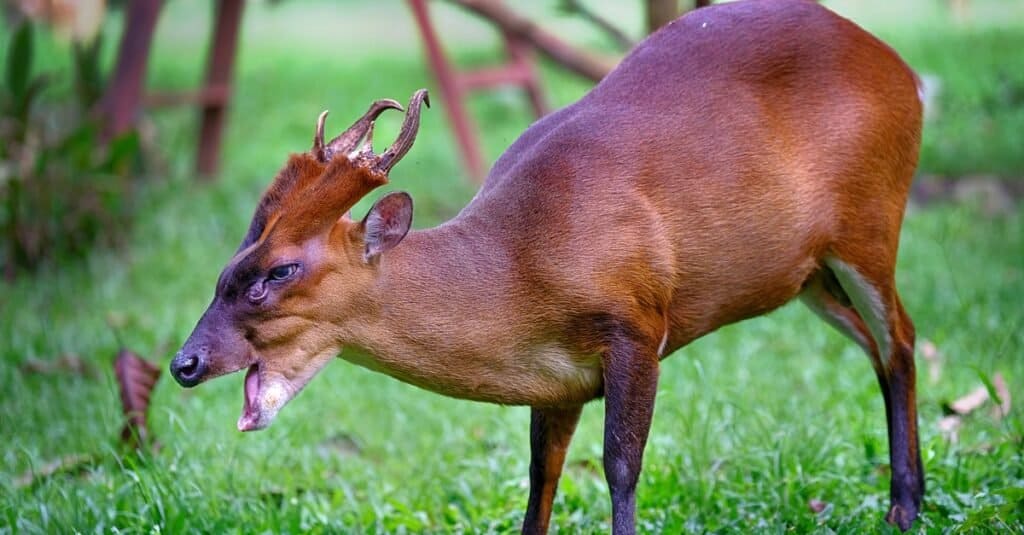If you’ve ever seen a muntjac, you’ve probably noticed the “holes” on its face, as some people call it. Well, these aren’t holes; they are just scent glands muntjacs use to mark their territories. Besides this, muntjacs are the only deer species with frontal glands, meaning the “V” on their foreheads. If you want to learn more about these, keep reading!
Muntjac Face Scent Glands

Male muntjac preorbital glands are larger than those of female deer.
©Erni/Shutterstock.com
Muntjac deer have both frontal and preorbital glands. In fact, they are the only deer species to possess frontal glands. If you look at their faces, you’ll notice a “V” shape on their foreheads – these are the frontal glands, which are a “pair of slits on the face in line with the antler pedicles,” as per this study. Male muntjac preorbital glands are larger than those of female deer. Moreover, Reeves’s muntjacs have larger preorbital glands than Indian muntjacs.
What Is a Preorbital Gland?
A preorbital gland is an exocrine gland. Exocrine glands, in turn, are those that secrete substances by way of a duct. Exocrine glands include mammary, salivary, lacrimal, and mucous glands. In hoofed animals, preorbital glands are similar to the human lacrimal gland.
Which Animals Have Preorbital Glands?
As mentioned above, a preorbital gland is an exocrine gland and muntjac deer aren’t the only animals with these types of glands. The gland is made up of a glandular region located in a pouch found near the nasal corner of the eye of the hoofed animal.
Other familiar animals have exocrine glands such as skunks and weasels, however, it does not produce the same type of scent glad that preorbital glands offer hoofed creatures.
Four-legged animals aren’t the only creatures in the animal kingdom with scent glands. In fact, cloacal scent glands are often present in snakes. These glands expand and secrete a thick fluid that is odoriferous.
Furthermore, preorbital glands are often found in hoofed animals, these animals include:
Similar animals such as other species of deer also have preorbital glands. Because of its role in scent marking, the preorbital gland is considered a scent gland. A function of these glands may be to produce antimicrobial compounds to fight against skin pathogens.
How Do Muntjacs Use Their Facial Glands To Mark Territory?
This deer species uses its facial glands to mark the ground by rubbing them against vegetation.
Here’s how a muntjac does this:
- approaches a recognizable spot
- sniffs it
- opens its frontal and preorbital glands and tilts its head forward
- applies its face on the ground and brushes its glands
- raises its head
- closes its frontal glands and keeps only the preorbital glands open
- defecates while slapping both opened preorbital glands
- urinates while licking both opened preorbital glands.
Can Muntjacs Open Their Facial Glands?

Some deer keep their preorbital glands open when resting.
©iStock.com/Sourabh Bharti
Yes, muntjacs can open their facial glands.
When the deer poops or urinates, it opens its frontal and preorbital glands. Fawns start licking their preorbital glands from their very first defecation and urination. Sometimes preorbital glands are also opened as part of social display. Some deer keep their preorbital glands open when resting.
On the other hand, the frontal glands are opened when the deer chews on something hard, such as a piece of bone. Thus, they can open when the deer desires it, or this happens involuntarily, “forced” by other facial muscles.
The frontal glands can be opened only about 0.39 inches wide. In contrast, preorbital glands are much larger when open and can be everted. This means muntjacs can turn their glands inside out.
Besides marking their territories, deer use their scent glands to communicate with other deer. For example, female deer often open their preorbital glands when caring for their fawns. Moreover, some deer can rub their preorbital glands on a branch only for pleasure.
Are Muntjacs the Only Deer With Preorbital Glands?

Black-tailed deer have 1.3-inch long preorbital glands.
©iStock.com/Elizabeth Lara
While they’re the only deer species with frontal glands, preorbital glands are present in many other deer. White-tailed deer, for instance, one of the most common in North America, have 0.87-inch long preorbital glands. That mule deer measures 1.6 inches long, while black-tailed deer have 1.3 inches long preorbital glands.
Red deer is another species with preorbital glands, which are extremely important for calves because they indicate their stress levels. Stressed calves will have open preorbital glands, while relaxed calves’ preorbital glands are closed. Moreover, calves will open their glands when they’re hungry and close them once they’re full.
Muntjac Preorbital Glands vs. North American Deer Preorbital Glands
A study comparing the facial muscles and glands of two muntjac fawns with those of adult North American cervids showed that, although the involved fawns were only ten days old, their muscles linked to their preorbital glands were much larger.
Moreover, they possessed a specific muscle that allowed them to turn their preorbital glands inside out. This muscle was missing in North American deer.
What Other Scent Glands Do Deer Have?
Deer typically have seven types of scent glands that are located across their bodies. These glands include:
- Forehead glands
- Preorbital glands, located below the eyes
- Nasal glands, located inside the nostrils
- Interdigital glands, located between the toes
- Preputial glands, located inside the deer’s penis’ foreskin
- Metatarsal glands, located on the outside of the hind legs
- Tarsal glands, located on the inside of the hind legs
Incredible Muntjac Facts

The Indian muntjac is the mammal with the lowest chromosome variations.
©PLOO Galary/Shutterstock.com
If the muntjac’s unique facial glands made you curious enough, we’ve prepared some other incredible facts about this deer species!
- Muntjacs are believed to have inhabited Earth more than 15 million years ago!
- The IUCN lists most muntjac subspecies as the Least Concern. However, the giant muntjac is Critically Endangered, the Bornean yellow muntjac is Near Threatened, and the black muntjac is Vulnerable.
- There’s an invasive muntjac species in the United Kingdom, which descended from some deer that had escaped the Woburn Abbey estate in 1925.
- The Indian muntjac is the mammal with the lowest chromosome variations. Male Indian muntjacs have seven chromosomes, while female Indian muntjacs have six. In contrast, Reeves’s muntjacs have 46 chromosomes.
- Indian muntjacs are also called “barking deer” because they produce a bark-like sound when they feel threatened. This way, they alarm other deer about the imminent danger.
How Long Do Muntjacs Live?
These generally solitary creatures live an average of 18 years. Does usually live longer than bucks – who spend their time defending small territories against other bucks while females raise fawns. Muntjac does not have a defined breeding season and breed all year round. Does are capable of conceiving again within days of giving birth.
The gestation period for a muntjac is seven months – and seven months after they are born, female muntjacs are ready to mate. Does and their babies communicate with a series of squeaks and are active throughout the day with peak activity being at dusk and dawn. Muntjacs spend long periods lying around ruminating after meals.
Do Female Deer Have Scent Glands?
Typically, deer keep their glands closed, but they can intentionally open them to release an odor in specific situations. For instance, during the rutting season, a male deer may dilate its preorbital glands to convey aggression to another male in the vicinity.
Female deer, on the other hand, commonly open these glands while tending to their offspring.
Furthermore, the tarsal gland area on a deer’s leg has long hairs and big, fatty glands that have a bit of a musky smell. Both male and female deer have these different types of glands.
The photo featured at the top of this post is © iStock.com/MikeLane45
Sources
- National Library of Medicine, Available here: https://www.ncbi.nlm.nih.gov/pmc/articles/PMC1231931/
- Discover Wildlife, Available here: https://www.discoverwildlife.com/uncategorized/understand-mammal-behaviour-part-9-muntjac-deer/
Thank you for reading! Have some feedback for us? Contact the AZ Animals editorial team.






